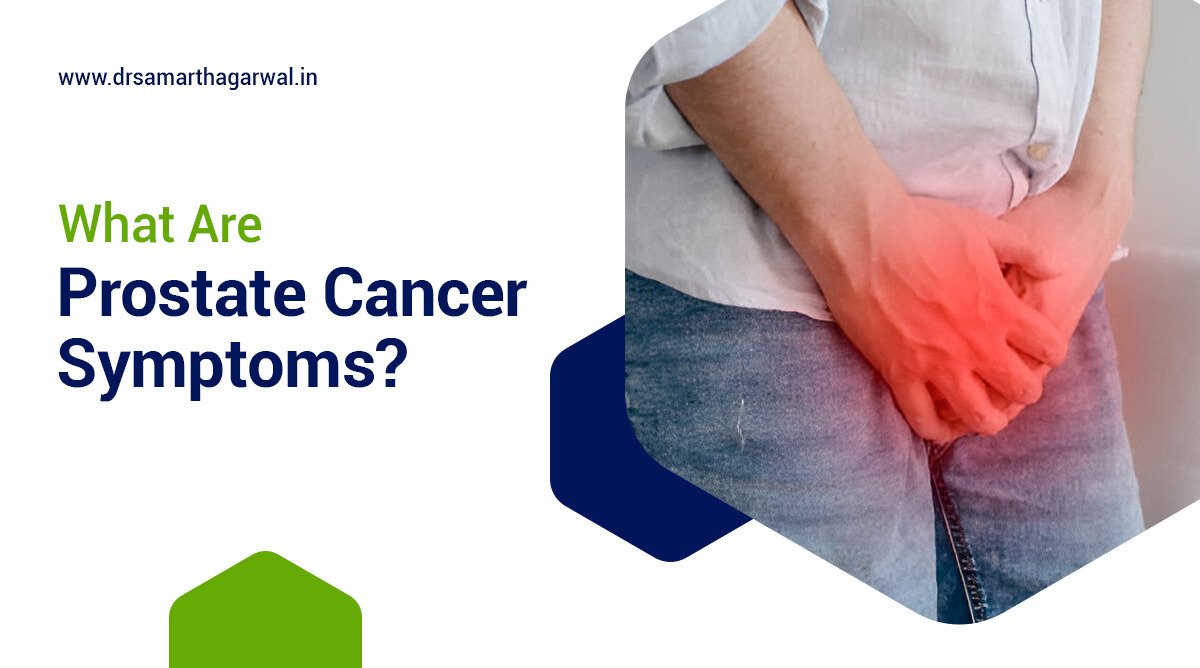Prostate cancer is a serious disease that affects men and is often asymptomatic, posing dire consequences if left untreated. Recognizing the symptoms of prostate cancer is crucial for early diagnosis and effective treatment. This article explores the nature of prostate cancer, highlighting common early warning signs and symptoms that may arise as the disease progresses. Additionally, we will discuss diagnostic methods, various treatment options, and preventive measures that can help reduce the risk of developing this condition.
According to Hariharan, K.’s 2016 study, ‘Demography and disease characteristics of prostate cancer in India.’, prostate cancer in India shows varying incidence rates from 5.0-9.1 per 100,000/year, with significant urban-rural disparities. While rural areas like Barshi report lower rates (1.5/100,000), urban centers like Mumbai and Jaipur show higher incidences (7.1 and 11.6/100,000 respectively). A concerning statistic reveals that 85% of cases in India are detected in late stages (III and IV), compared to only 15% in the United States. Regional variations indicate higher prevalence among North Indians compared to South Indians, with the disease ranking as the fifth most common cancer in Delhi and ninth in Tamil Nadu. The urban-rural disparity is attributed to limited awareness and poor documentation in rural areas
What is Prostate Cancer?
Prostate cancer refers to the uncontrolled proliferation of cancer cells in the prostate gland and is the most common cancer affecting men worldwide. While prostate cancer is primarily categorized as adenocarcinoma, it can also arise from other types of prostate cells, including neuroendocrine cells, as well as from the stromal cells of the prostate gland. The development of this malignancy is influenced by various factors, with age, genetic predisposition, and lifestyle choices being the most significant. This combination of factors makes prostate cancer a challenging public health issue.
The most potent risk factor for prostate cancer is advanced age, as evidenced by the rapidly increasing incidence rates after the age of 50. The prostate plays a crucial role in producing a significant portion of the fluid that composes male seminal fluid. Prostate cancer can present in various types, some of which, such as small cell carcinoma or transitional cell carcinoma, are considered more aggressive.
Understanding the different characteristics of the various types of prostate cancer is essential, as these differences can have a significant impact on health, affecting both life expectancy and quality of life, and may necessitate surgery or more intensive follow-up care.
Common Symptoms of Prostate Cancer
Recognizing the most common symptoms of prostate cancer is crucial for effective diagnosis and intervention, as early detection often plays a key role in successful treatment.
The primary symptoms of prostate cancer include:
- Urinary issues
- Difficulty urinating
- Frequent urination
- Back pain
- Unexplained weight loss
However, these symptoms may also indicate other health concerns, making it essential for men to consult their healthcare providers if they notice any troubling changes.
Early Warning Signs
The early warning signs of prostate cancer often manifest as urinary symptoms, including increased frequency of urination, difficulty starting or stopping urination, and painful urination.
Initially, these symptoms may be mistaken for non-serious conditions such as urinary tract infections or benign prostatic hyperplasia. Therefore, it is important to monitor the duration of these symptoms and note any accompanying changes.
Ignoring these early warning signs can result in delayed diagnosis and treatment, leading to a significant decline in health outcomes. Regular screening tests, such as prostate-specific antigen (PSA) tests and digital rectal exams, are essential for early detection and can assist healthcare providers in identifying potential issues.
Individuals experiencing these urinary symptoms should contact their healthcare professional promptly for a thorough assessment. This proactive approach can help ensure peace of mind and promote effective health management.
Advanced Symptoms
Advanced prostate cancer symptoms can include weight loss, back pain, and various other pains that significantly impact quality of life as the disease progresses and spreads beyond the prostate gland.
These symptoms often indicate that the cancer has metastasized, potentially affecting the bones and nearby organs.
Patients frequently report a level of fatigue that is distinct from ordinary tiredness, preventing them from engaging in their daily activities. Additionally, emotional distress may manifest as anxiety and depression as patients cope with their diagnosis.
The combination of physical and emotional pain underscores the importance of medical treatment for individuals with prostate cancer. Early diagnosis of these advanced symptoms can prompt timely interventions that help manage symptoms and enhance overall quality of life.
Diagnosing Prostate Cancer
Prostate cancer diagnosis involves a combination of screening tests and diagnostic techniques to detect the presence and extent of the disease.
The primary screening methods for diagnosing prostate cancer include the prostate-specific antigen (PSA) test and the Digital Rectal Exam (DRE). These methods evaluate a man’s prostate health and help identify potential abnormalities in the prostate gland.
If any abnormalities are found, additional diagnostic procedures such as a biopsy, MRI, CT scan, or PET scan may be performed to confirm the presence of cancer cells.
Screening Tests
Screening tests for prostate cancer include the prostate-specific antigen (PSA) test and the Digital Rectal Exam (DRE). These tests are crucial for the early detection of prostate issues and may lead to more effective treatment options.
The PSA test measures the level of this protein in the blood; higher levels may indicate the need for further testing. The DRE involves a healthcare provider manually checking the prostate for abnormalities using their fingers.
However, both tests have limitations; for instance, PSA levels can be influenced by conditions other than cancer, and the DRE may not detect every potential issue.
It is essential to determine the appropriate frequency for these screenings, particularly for men over 50 or those with a family history of prostate cancer or from certain ethnic backgrounds, to maximize the chances of detecting problems at the earliest possible stage.
Diagnostic Techniques
Diagnostic techniques such as biopsy, MRI, CT scan, and PET scan are employed after initial screening tests suggest the possibility of prostate cancer.
These methods are essential for confirming the diagnosis and staging of the disease, providing a comprehensive understanding of the patient’s condition.
A prostate biopsy involves collecting small tissue samples that are examined under a microscope to identify the presence of cancerous cells.
MRI utilizes magnetic fields and radio waves to produce detailed images of the prostate gland and surrounding tissues, aiding in the assessment of the tumor’s size and location.
CT scans generate cross-sectional images of the body, helping doctors determine whether the cancer has spread to nearby lymph nodes or other organs.
PET scans identify areas of increased metabolic activity, which may indicate cancerous growths.
When used in conjunction, these diagnostic techniques not only confirm the diagnosis of prostate cancer but also assist in staging it, which is crucial for determining the most appropriate treatment options moving forward.
Treatment Options for Prostate Cancer
Treatment options for prostate cancer vary depending on the stage of the condition and include radical prostatectomy, radiation therapy, chemotherapy, and hormonal therapy.
Each treatment modality has specific indications and potential side effects, making it essential for patients to engage in informed discussions with their healthcare providers. This collaborative approach helps ensure that they choose the most appropriate treatment option for their individual circumstances.
Surgery
Surgery, particularly radical prostatectomy, is a common treatment option for localized prostate cancer. This procedure involves the complete removal of the prostate gland along with surrounding tissue.
The primary goal is to eliminate cancer by excising not only the prostate but also some nearby lymph nodes that may contain cancer cells. After the surgery, patients typically undergo an extensive recovery period, during which they must manage potential side effects such as incontinence and erectile dysfunction.
While many individuals experience significant improvements in their quality of life, the implications of this surgery can vary widely based on factors such as age and overall health. In comparison to other surgical interventions, such as laparoscopic or robotic-assisted procedures, a radical prostatectomy may offer different recovery experiences and outcomes.
Understanding these nuances is essential for patients as they make informed decisions about their cancer treatment options.
Radiation Therapy
Radiation therapy is a treatment for prostate cancer that utilizes high-energy rays to destroy cancer cells while minimizing damage to surrounding healthy tissue. This treatment may be administered in various ways, with the most common methods being external beam therapy and brachytherapy.
External beam therapy involves delivering radiation from outside the body. This process typically occurs over multiple sessions at a medical facility equipped with the necessary technology and trained personnel to accurately target tumor locations identified through imaging techniques.
Brachytherapy, on the other hand, involves placing radioactive seeds directly into or very close to the tumor, ensuring a high dose of radiation reaches the cancer while reducing exposure to nearby healthy tissue.
While radiation therapy is primarily used with curative intent, it also plays a significant role in palliative care by alleviating symptoms and enhancing the quality of life for patients with advanced disease. Patients may experience a range of side effects, including fatigue, skin irritation, and urinary issues, which should be thoroughly discussed with their healthcare professionals.
Hormone Therapy
Hormonal therapy is a systemic treatment option for prostate cancer that aims to reduce levels of male hormones, such as testosterone, which can fuel the proliferation of cancer cells. This approach is essential for controlling the progression of the disease, particularly when it has spread beyond the prostate.
One commonly used form of this therapy is androgen deprivation therapy (ADT), which involves medications that block hormone production or action. This treatment is often used in combination with other therapies, such as radiation, to enhance overall effectiveness.
Patients receiving hormonal therapy should be aware of potential side effects, including fatigue, hot flashes, and decreased bone density. Therefore, regular monitoring is necessary to manage any adverse effects and adjust treatments as needed to achieve the best outcomes.
Preventing Prostate Cancer
The most effective way to prevent prostate cancer is to be aware of its risk factors and make lifestyle adjustments that support prostate health.
This includes adopting a balanced diet, engaging in regular exercise, and scheduling routine medical examinations.
Lifestyle Changes and Risk Factors
Lifestyle changes can play a significant role in preventing prostate cancer by reducing known risk factors and enhancing overall prostate health. These changes include adopting a balanced diet rich in fresh fruits, vegetables, and healthy fats, which is associated with a lower risk of cancer.
Engaging in regular physical exercise not only aids in weight management but also helps maintain balanced hormone levels, which in turn can reduce the risk of prostate cancer. It is also important to understand risk factors such as age, family history, and ethnicity, as certain groups, such as African American men, are at greater risk.
By making informed lifestyle choices, individuals can take proactive steps towards their health, ultimately reducing the likelihood of developing prostate cancer and other prostate-related issues.

Contact Dr. Samarth Agarwal if you have any questions or concerns about prostate cancer!




